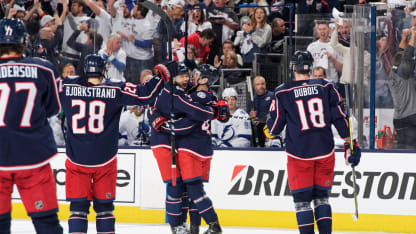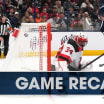This week, BlueJackets.com is taking a look at a few ways in which the game of hockey is changing right before our eyes. From a game that's getting faster by the second to one increasingly impacted by analytics off the ice, the NHL and the Blue Jackets are in the midst of an age of rapid transition. This week's stories will take a look at those trends across the league and how the Blue Jackets are staying at the forefront of all that is going on.
As we detail the changes to the NHL game that have taken place over the past few seasons, we should look forward as well, and fans should be prepared for a major new development upcoming during the 2019-20 season.
The NHL
announced in January
that it will use sensors to track its player and puck movement during all game action this season, creating a treasure trove of data that will have plenty of impact on how the game is digested by both fans and league front offices over the coming seasons.
The Changing NHL: Analytics continue to gain foothold on the ice
League's plan to track player, puck movement to provide even more data to teams, fans

© Jamie Sabau
The tracking system, which was tried out last season during NHL All-Star Weekend as well as in a regular-season cameo featuring the Vegas Golden Knights, will be the latest -- and perhaps most significant -- effort to dig into what's really happening during NHL games.
No longer are goals, assist, penalty minutes, plus-minus and goals-against average the only ways in which to measure players, nor are team stats limited to goals per game or goals allowed averages.
As the analytics movement in the sport of hockey has grown, the ways to judge the contributions of players and evaluations of teams have changed -- and in many ways improved.
THE CHANGING NHL: Speed kills | A new world for goalies
And as the league's tracking data -- which will include sensors in both the puck and players' shoulder pads as well as antennae and cameras in arena rafters -- yields more and more data, the Blue Jackets will approach it as they have all such changes in the game over the past few years: By doing their best to digest it and learning as they go.
"We're trying to stay in front of it," Columbus assistant general manager Josh Flynn said. "It's going to be interesting."
The Blue Jackets are doing what they can to stay ready to take advantage of new insights into the game. Earlier this offseason, Columbus announced the hiring of Zac Urback to serve as a hockey analyst after he spent two years building an analytics department with the Mississauga Steelheads of the OHL.
In addition, the new frontier won't be all new for the franchise. For the past two seasons, Columbus has made use of data from Sportlogiq, a sports analytics company that has provided the Blue Jackets with player tracking data as well as other insights like possession time, matchup data and much more.
As one might expect, as the front office's understanding of the data has grown, the data's usefulness has as well.
"At first, I don't know how much value we will get out of (the new NHL data)," Flynn said. "We get more value out of Sportlogiq now than we used to, not necessarily because anything changed with their product, but we know better how to use it. It's just going to be about getting a handle on the new data that's coming in and seeing what we can do with it."
Trying to stay on the cutting edge has been a focus for the Blue Jackets under general manager Jarmo Kekalainen and Flynn, who has overseen the team's analytics department in recent seasons. The team has used work from Urback the past two seasons when it comes to evaluating draft prospects, and the analytics work has also had a day-to-day impact with the team as well.
Flynn has created a one-page postgame analytics report after each game in recent seasons that is distributed among the team, with a focus on providing concise, easy-to-digest information for players and coaches -- including head coach John Tortorella -- that want it.
Flynn has been putting together a two-page analytics-based report on players the team is targeting that is used along with scouting data and other factors in team discussions at the trade deadline and in free agency.
"It's not necessarily saying, 'How good is this player?' " Flynn said. "It's saying, 'What are the red flags the analytics are pointing out? What are the green flags? What do they say he's specifically good at that can fit our team or not fit our team? Is he overproducing or underproducing based on underlying numbers?'"
On a more macro level, analytics can help bring better answers to the questions that need answered in a sport as dynamic as hockey. With 12 players skating around at speeds that can top 20 miles per hour as well as a puck flying around that can reach 100 mph, there are seemingly infinite variables that can be studied.
While traditional metrics will always be the backbone of the game to many -- and a goal will always be a goal on the scoreboard -- the context that digging deeper can add can be invaluable. After all, not all tallies, from one-inch tap-ins to 40-foot snipes, are created equal, and a second assist can range from a valuable pass that springs someone open to a touch 10 seconds before a goal.
With data can come context and more accurate conclusions about what is happening on the ice and why it's happening.
"This week, Jarmo called me and he had been talking to people from an organization outside the NHL, and they pointed out something in their league," Flynn said. "And then I turned around and said, 'Well, let's look at it in our league,' and using a company like Sportlogiq, we can have them query something like that really quickly and we had the same metric they had in a day. Before the power of systems like that, you couldn't get that."
For Flynn, having a hand in all of this something akin to a dream job. The Toronto native set his sights in high school on working for a hockey front office and, after two years with the KO Sports Agency in Denver, saw his efforts come to fruition in 2008 when he was hired to be the Blue Jackets' salary cap expert.
Promoted this summer from director of hockey administration to assistant GM, Flynn has worked his way to the point he has a hand in most arms of the team's hockey operations, from negotiating contracts to scouting players to salary cap management to working with the league on matters regarding the collective bargaining agreement.
When he was hired, the analytics movement was in its infancy. Now, there are more and more tools to evaluate player and team performance beyond simply the traditional metrics and the eye test, and after saying analysts were just scratching the surface a few years ago, Flynn says the pipeline of knowledge continues to flow.
"We're maybe a little below the surface now, but we have a ways to go," said Flynn, who spoke on a panel at the prestigious Sloan Analytics Conference hosted by MIT in 2017. "Two years ago, we started with Sportlogiq, and I think back on this a lot that if we knew what we've learned from studying this stuff back then, are there any decisions that we would have made differently?
"I don't know that the answer is yes or no, but I think about these things. It's definitely added a layer of knowledge for us. I think we're a little below the surface now, but we're still trying to go deeper."


















